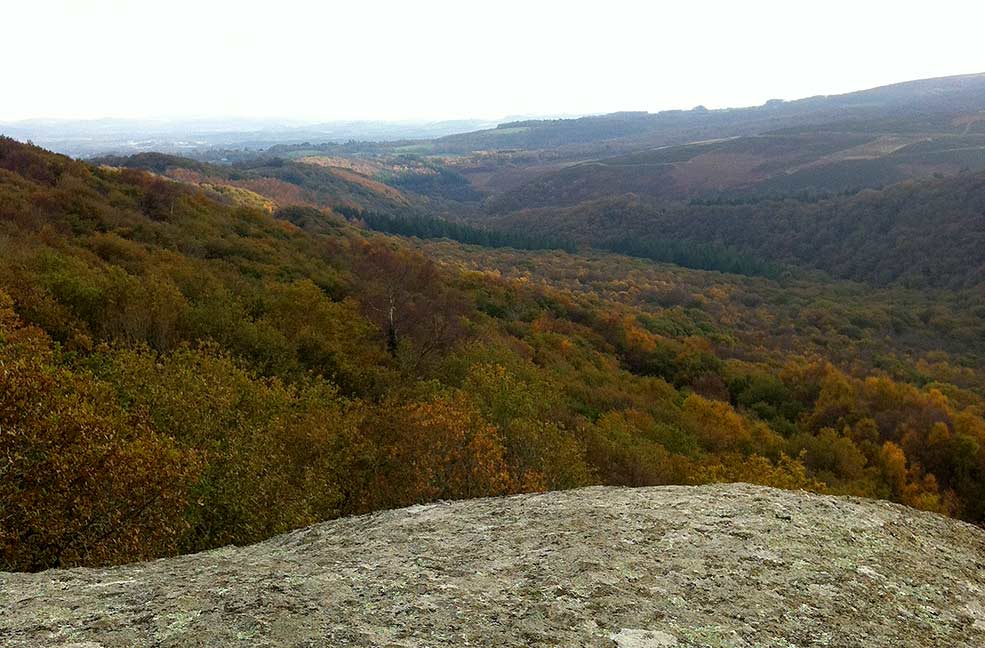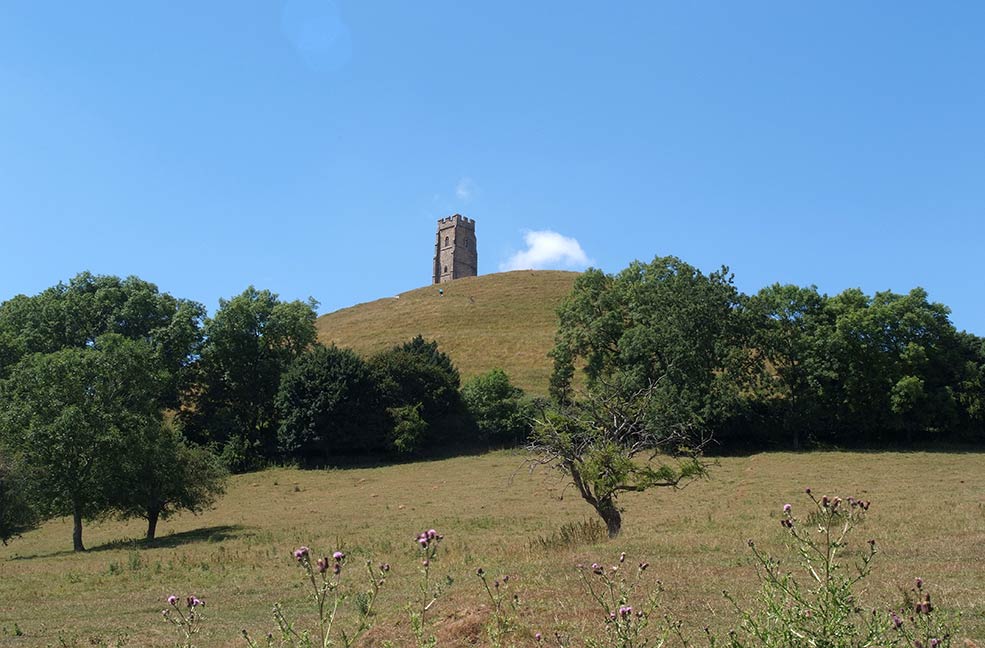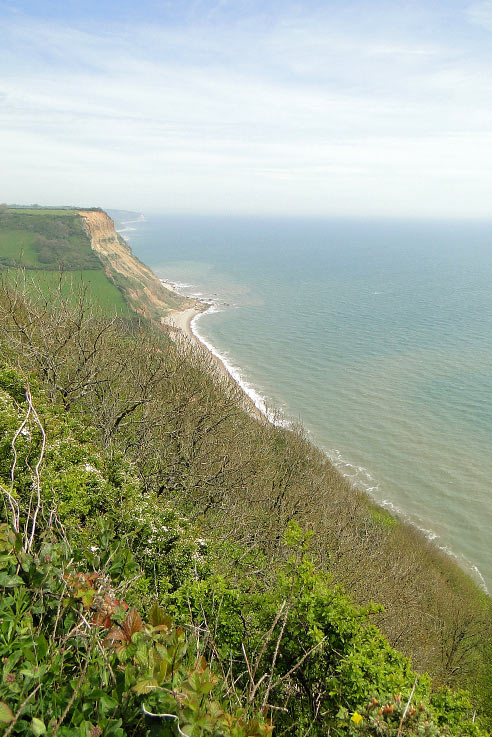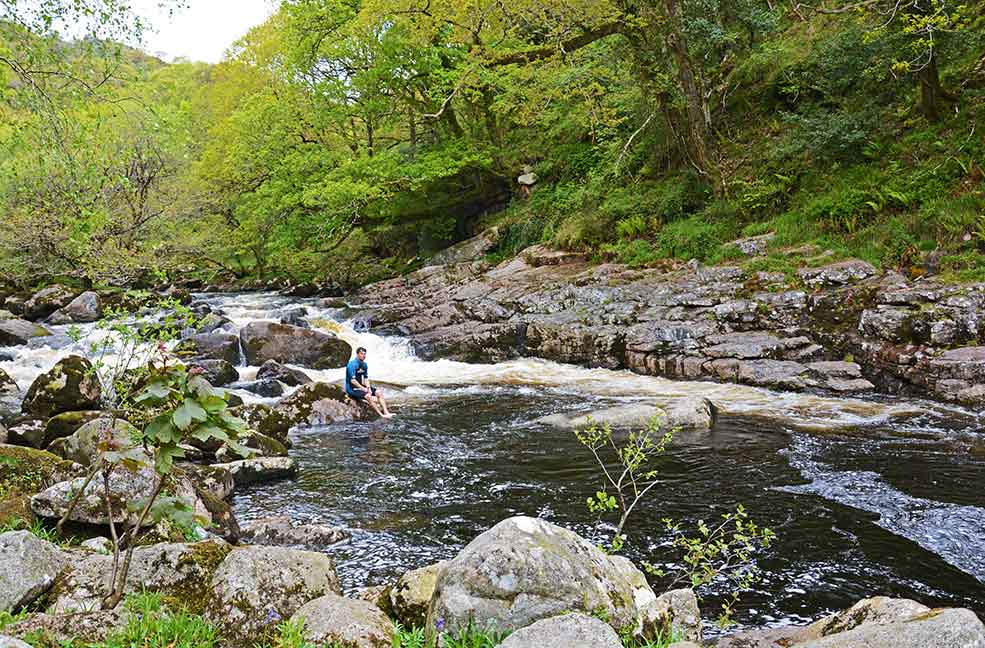Covering parts of Somerset and North Devon, Exmoor National Park’s moorland heaths, towering cliffs, and coastal woodland habitats offer plenty to explore. As you roam its heather-covered moors, you’ll spot red deer and free-roaming Exmoor ponies, while its coastline offers harboured coastal towns, secluded beaches, and the starting point of the South West Coast Path.
Its rural countryside reveals traces of ancient settlements, intermingled with historic estates, and its clear rivers and deep combes provide intriguing grounds for hiking and walking.
Altogether, Exmoor provides an opportunity to delve deeper into the richness of Britain’s natural beauty and heritage. Here’s everything you need to know to make the most of your visit to Exmoor National Park.
About Exmoor National Park
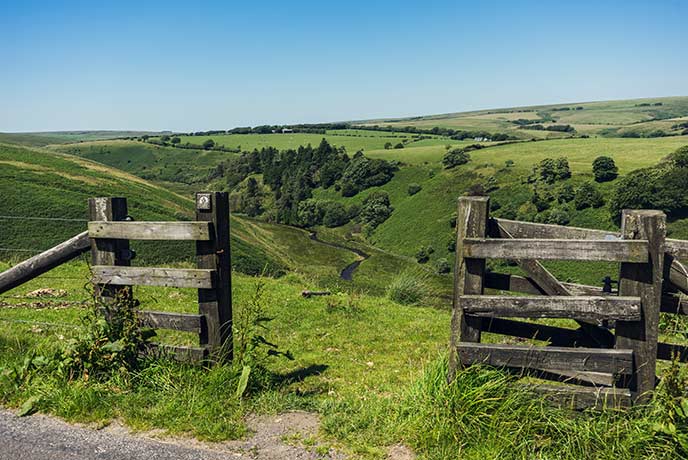
Though it may appear rugged and untouched, Exmoor has been shaped by thousands of years of human activity – from farming and mining to settlement and recreation. It’s also the starting point of the South West Coast Path, the longest waymarked walking route in England and Wales.
Exmoor gained its National Park designation in 1954 to protect this complex and historic landscape, where you’ll discover rural communities, locally distinctive breeds of animals, a Dark Sky Park and an exceptional rights of way network – all culminating in an area which provides superb opportunities for walking, riding and cycling, plus insight into how people lived in the area for the past 8,000 years.
Landscape
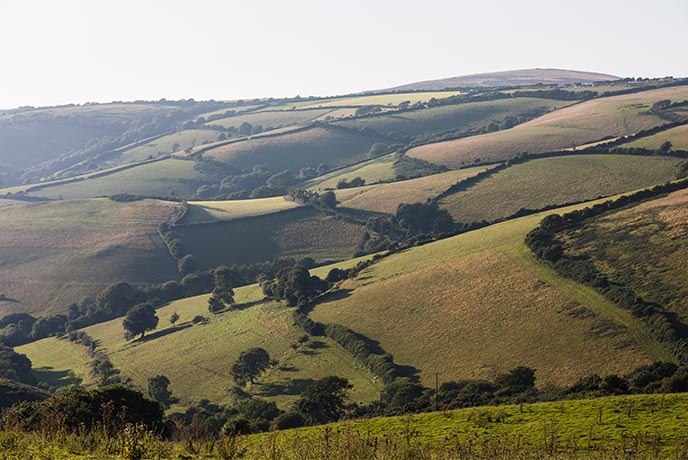
When most people think of Exmoor, it’s the wild, elevated moorlands that come to mind. But its landscapes offer much more. Towering sea cliffs – the highest in England – reveal geological layers from the Devonian period, while rolling farmland and heathlands bear traces of ancient settlements. Along its 37 miles of coastline, far-reaching views stretch across the Bristol Channel, where navigators have long battled the world’s second-strongest tides.
Named after the River Exe, Exmoor’s flowing rivers and deep combes, carved by ancient waterways, are key features of the landscape. The National Park also contains the longest stretch of continuous coastal woodland in England – ‘Atlantic’ sessile oak forests shaped by centuries of human use, now home to a rich variety of wildlife.
Wildlife
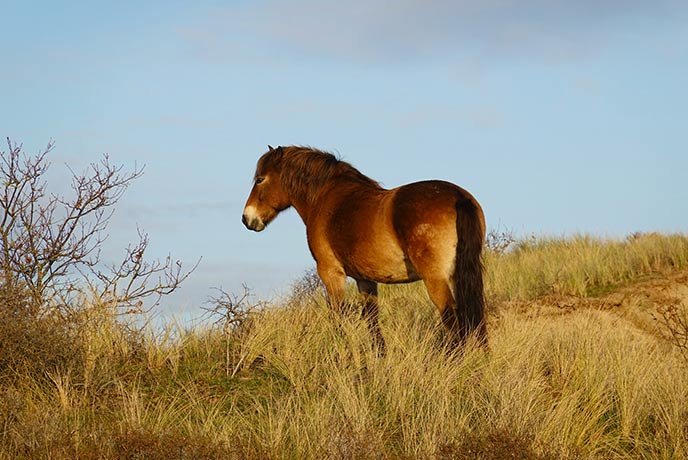
Exmoor National Park’s landscape combines a fascinating blend of habitats, offering a huge variety for visitors and some of the UK’s most precious wildlife species.
Once a Royal Forest reserved for hunting, Exmoor is now a sanctuary for red deer, Britain’s largest native land mammal. With over 3,000 roaming freely across moorland, farmland, and wooded valleys, these majestic creatures add to the magic of the Exmoor experience. Visit in spring and summer for a chance to see young fawns, or in the autumn to see stags rutting.
Exmoor is home to around twenty herds of free-roaming Exmoor ponies, the oldest native pony species in Britain. These docile animals don glossy coats in a variety of shades of brown in the summer. In winter, they gain a more shaggy appearance as they grow a two-layer coat to protect them from the elements. Visit during the spring and summer to see new foals grazing the landscape alongside sheep and goats or visit the Exmoor Pony Centre to meet ponies up close.
Exmoor’s elevated terrain collects rainfall that, together with natural springs, feeds its network of fast-flowing, crystal-clear rivers. These waters create ideal spawning conditions for trout and salmon, which can often be spotted making their upstream journey along the River Exe during late summer and autumn. Other interesting wildlife to keep an eye out for include migratory birds like pied flycatchers, rare woodland lichens, and fritillary butterflies. Plus, there’s the opportunity to join bat-watching tours at night.
Beaches in Exmoor National Park
Visit one of these beaches to experience the beauty of the Exmoor coastline and to discover some of the best beaches on the South West Coast Path.
Minehead Beach
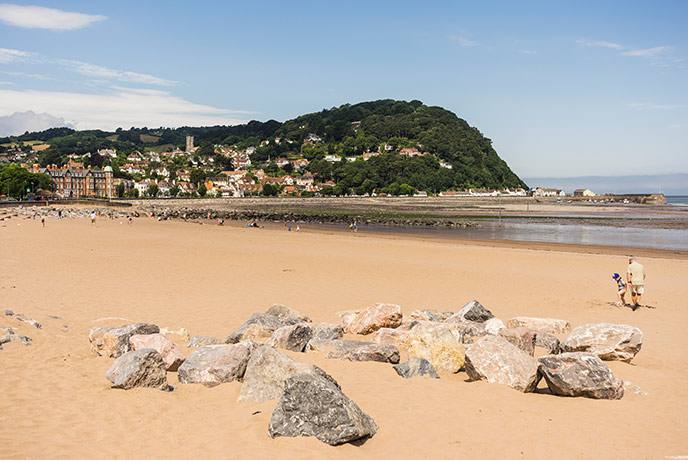
One of Somerset’s most popular family beaches, Minehead is a huge expanse of golden sand. Backed by a promenade, shops, arcade and with great local facilities, it’s always a convenient option. Dogs are allowed on some parts of the beach year round and the South West Coast Path starts just behind its western section.
Bossington Beach
Bossington’s pebbled shores lie at the eastern edge of Porlock Bay. It's a peaceful spot, with plenty of space backed by green hills and marshland. Coastal bird species like little egrets, curlews and oystercatchers are often drawn to the beach’s tidal pools, making it a hit with twitchers. A National Trust pay and display car park sits in the village of Bossington around half a mile away and the eastern edge of the beach is dog-friendly year-round.
Broadsands Beach
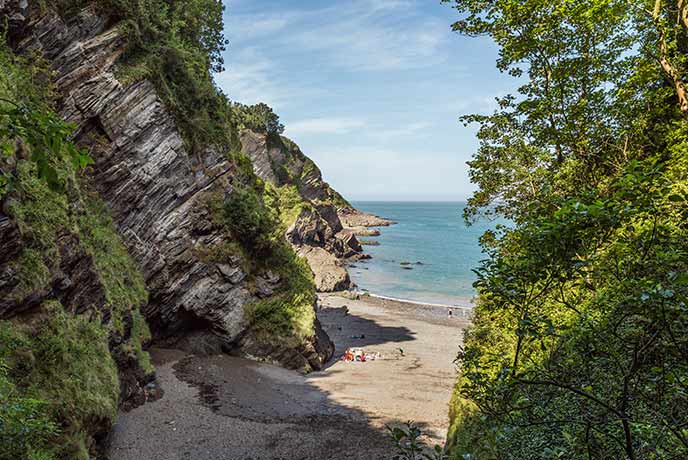
For those willing to put the effort in, Broadsands Beach is undoubtedly one of the most beautiful in the UK. A perfect arc of shingle, lying at the bottom of steep wooded cliffs, it's like something out of a movie. Access is via the South West Coast Path and down a set of 200 coastal steps (a challenge on the way back!) But it’s well worth it, especially at low tide when there’s more space to enjoy the views across Combe Martin Bay.
Lee Abbey Beach
Another family-friendly option, Lee Abbey Beach has easy access including a ramp. At low tide, visitors are greeted by a beautiful expanse of sand, rock, and pebble nestled within a wooded arc of coastline. Sheltered by the cliffs, it's a great spot for swimming, paddleboarding, and kayaking – though be aware that at mid-tide on this stretch of coast, the tide will be racing.
Towns and villages
With a combination of harboured seaside villages, rural hamlets, and characterful market towns, Exmoor has a base for all kinds of visitors.
Minehead
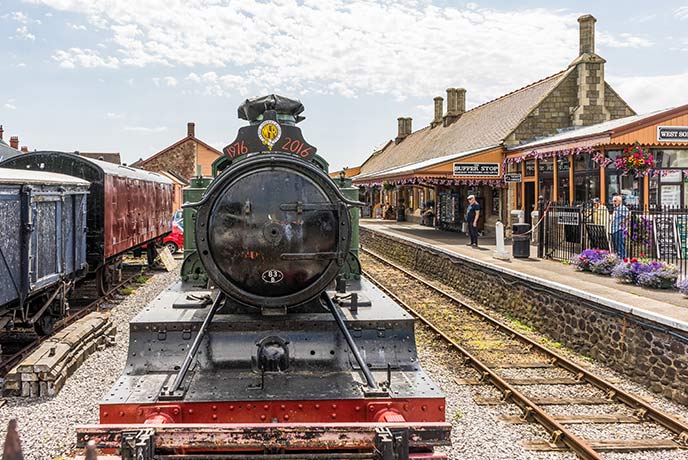
The starting point of the South West Coast Path, Minehead is the gateway to Exmoor, with plenty of access to walking routes inland as well. A classic seaside town with a long, flat sandy beach, harbour, and a promenade, it boasts a lively high street with plenty of cafés, restaurants, and shops to browse. Minehead is also home to one of the stops along the West Somerset Railway, making it perfect for those who love the nostalgia of a steam railway.
Porlock
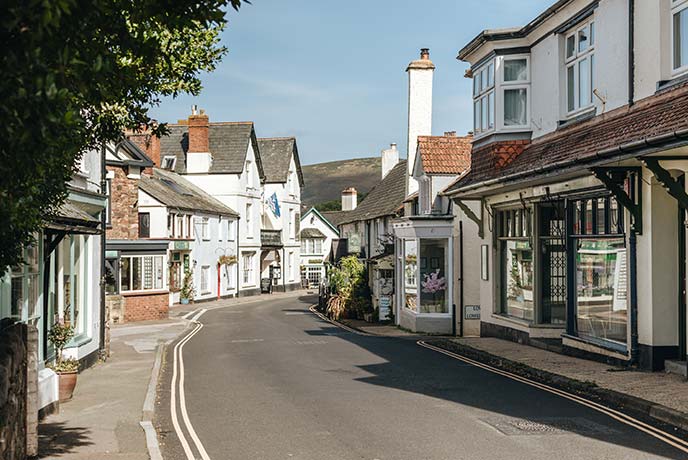
A relaxed and oh-so-picturesque fishing village with thatched cottages lining the water, Porlock is known for its views over the Bristol Channel and Exmoor landscape. Browse its galleries, relax in cosy pubs, or use it as a base for moorland walks and stargazing in the Exmoor Dark Skies Reserve.
Lynton and Lynmouth

Twin villages, stacked one on top of the other, Lynton and Lynmouth are connected by the famous cliff railway, which offers spectacular views over Lynmouth Bay. At the water’s edge, Lynmouth is a romantic seaside spot with a small collection of shops and fishing cottages clustered around the harbour. Lynton sits above, on higher ground, and is a tranquil town with Victorian architecture surrounded by wooded hills.
Dulverton
Exmoor’s southern gateway, Dulverton is a small market town tucked into a steep wooded valley. Pop into the visitor centre for tips on walking routes, or to borrow a telescope for stargazing. Explore independent shops, great pubs, and local history, including Exmoor’s oldest medieval bridge and the Dulverton Heritage Centre.
Dunster
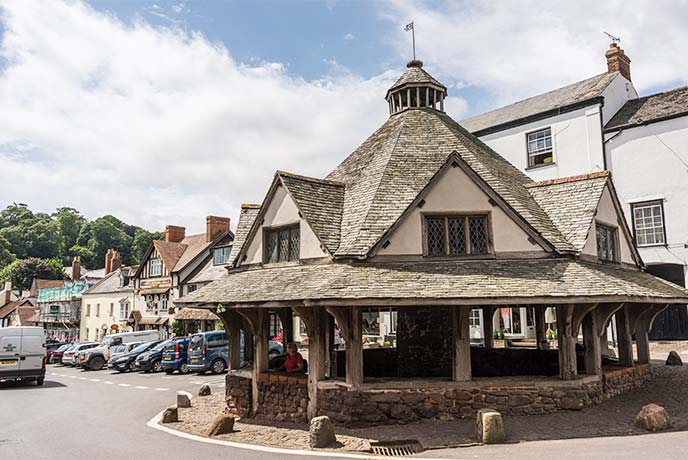
Nestled on Exmoor's northern edge, Dunster is a medieval village with oodles of charm, boasting a mix of fabulous boutiques and historic buildings for a wonderfully varied visit. Nearby Dunster Castle makes for a fascinating day out, while a cluster of tearooms beckon for light bites and aromatic coffees aplenty.
Withypool
For avid walkers, Withypool is perfectly positioned to access a beautiful selection of moorland, woodland, and riverside trails. Set astride the River Barle, the village itself provides a stunning setting, with a six-arch stone bridge and willow trees lining the water. The local pub and teahouse are also firm favourites in the area.
Things to do in Exmoor National Park
Don’t miss out on these days out while exploring Exmoor National Park. From historic estates and adventurous excursions to the chance to get up close to nature, there’s an activity for every occasion.
Arlington Court

Discover a lavish Regency house owned for 500 years by the Chichester family. Today, Arlington Court is managed by the National Trust, which preserves its Victorian garden, exotic plant conservatory, pleasure grounds and a nationally important collection of more than 40 carriages.
Dunster Castle
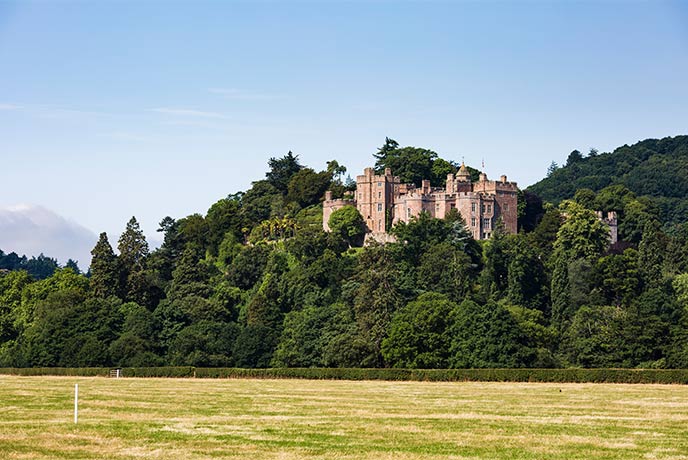
Perched on the top of a forested hill, Dunster Castle is a luxurious country home, which was originally the site of a Norman castle. Including terraced gardens, a still-functioning Victorian watermill, and extensive grounds, which include a river home to kingfishers, otters, and salmon, the castle grounds are just as rich as its decadent interiors.
Wimbleball Lake and Wistlandpound Reservoir
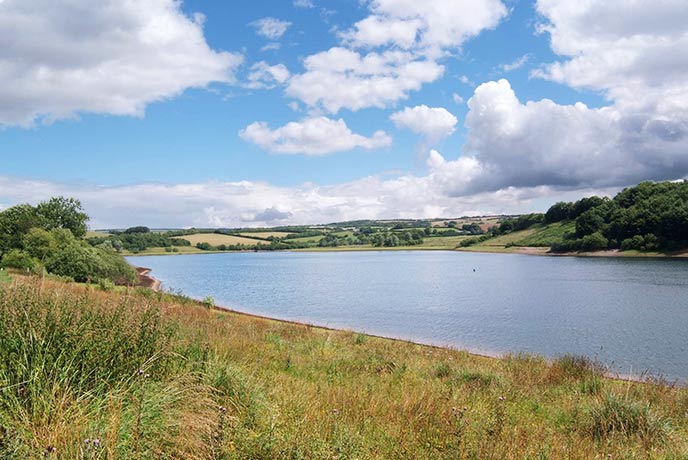
Owned by South West Lakes Trust, Wimbleball Lake and Wistlandpound Reservoir offer a fantastic range of activities surrounded by natural beauty. Hit the trails on foot or bike, or try your hand at sailing, paddleboarding, and kayaking. For anglers, there’s the opportunity to go trout fishing and by night they’re great spots for stargazing.
Valley of Rocks
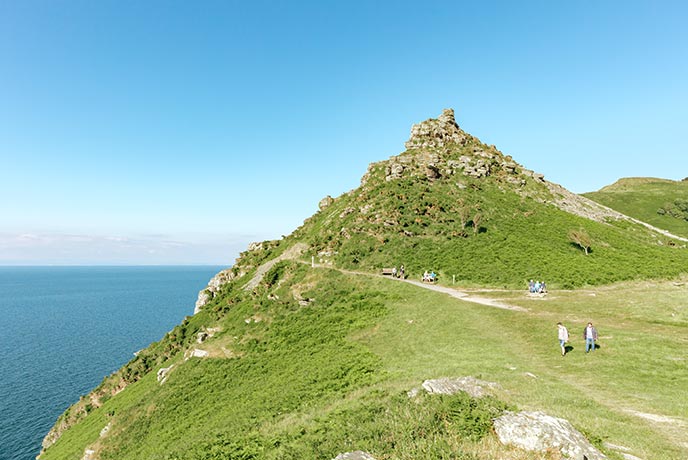
Near Lynton, the Valley of Rocks draws visitors with its awe-inspiring views over the Exmoor cliffs and Bristol Channel and has gained recent attention as one of the Salt Path filming locations. One of the most scenic parts of the South West Coast Path, expect grassy cliffs and craggy rock formations tumbling down to vast swathes of ocean. Plus, a chance to spot feral goats clinging to impossibly steep sections of the coastline.
Wildlife safari
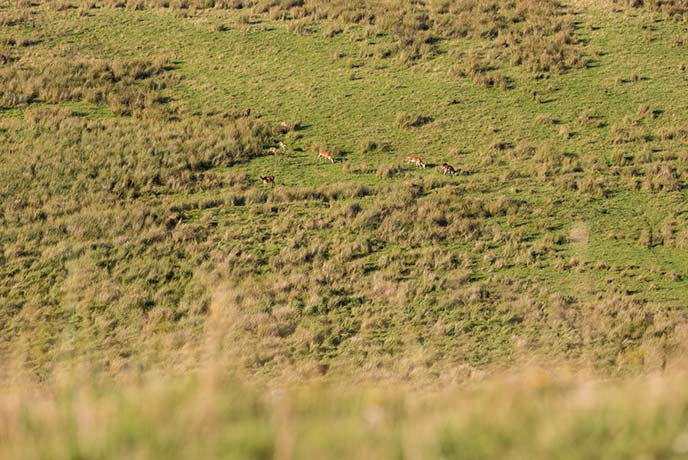
For deeper insight into Exmoor’s flora and fauna, guided wildlife safaris increase your chances of spotting red deer, Exmoor ponies, native birds and plant species. You’ll be shown around in a Land Rover Defender by a local expert who will also introduce you to Exmoor’s local myths and legends.
Stargazing
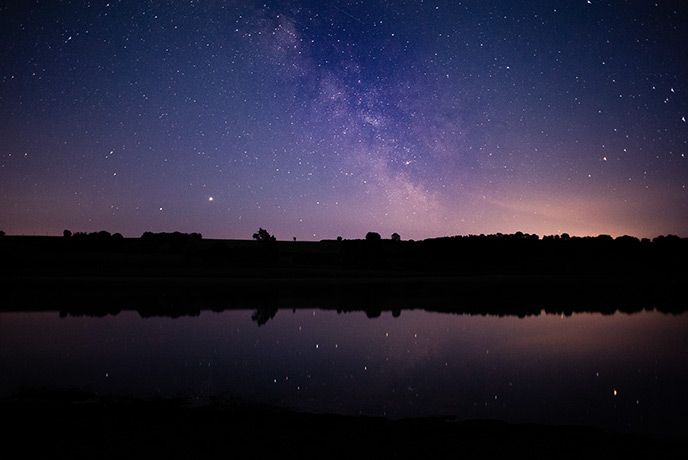
Exmoor is one of the UK’s Dark Sky Sites, which means it's been designated as one of the best places for stargazing. Rent a telescope from one of the visitor centres and head out after dark for the chance to gaze at the cosmos. The best locations are Holdstone Hill, Bredon Common, Wimbleball Lake, County Gate, Bossington Hill, Webber’s Post and Dunkery Beacon.
Cycling
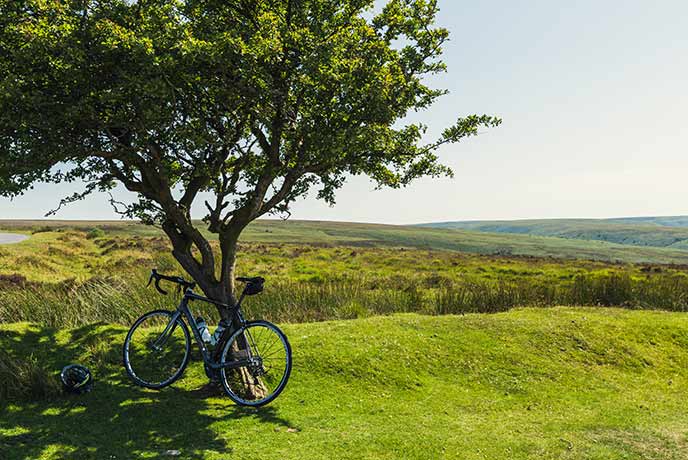
From gentle routes ideal for beginners and families to more challenging off-road mountain biking trails, cycling in Exmoor National Park offers something for all abilities. Ride along the higher ground for sweeping views of the countryside, or choose the shaded wooded valleys for a cooler, more leisurely experience.
Walks in Exmoor National Park
With over 600 miles of footpaths and bridleways, walking offers plentiful opportunities for exploring Exmoor’s beautiful landscapes.
South West Coast Path
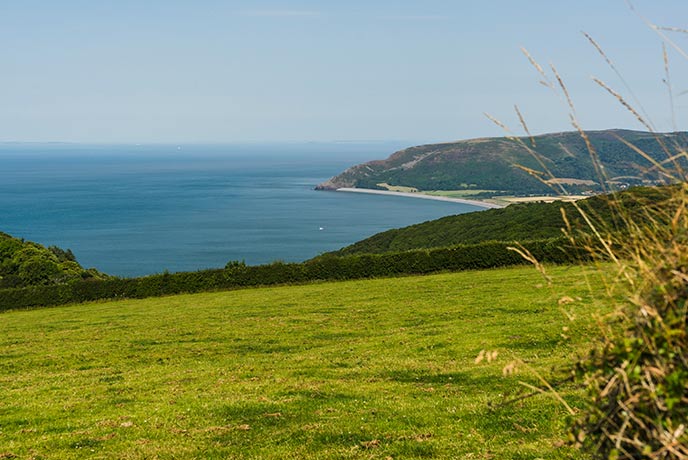
The first 35 miles of the 630 mile South West Coast Path runs along the Exmoor coastline. Though it may only total 5% of the route, this stretch is home to the tallest cliffs in England and Wales, the second-fastest tides in the world and the longest stretch of coastal woodland in England and Wales – making for a very special area. Hiking the coast path, you’ll also be able to stop off at a number of beautiful beaches, spot wildlife like free-roaming deer, ponies and goats. Plus, enjoy vantage points overlooking the Bristol Channel, plenty of cosy harbourside pubs and even a fossilised woodland.
Parracombe and Challacombe Circular
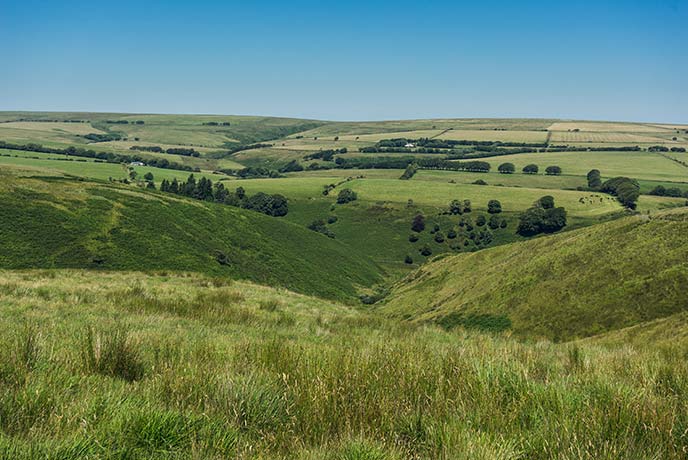
For an exploration of Exmoor’s uplands and insight into the area’s ancient history, a 13 mile circular from Parracombe via Challacombe Common provides the opportunity to discover standing stones, tumuli and cairns. A fairly challenging route, you’ll experience the heather-adorned wilderness of the moors and pass over some of Exmoor’s highest ground, where you’ll also spot Bronze Age burial mounds and elevated views over the Exmoor landscape.
Withypool and Tarr Steps
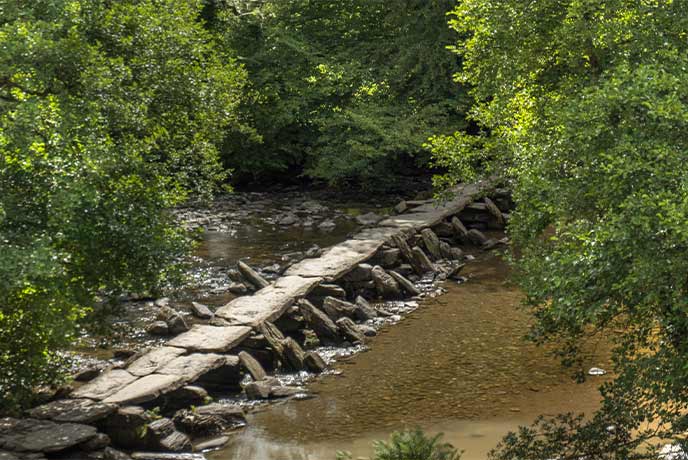
One of the best walks in Somerset, and starting in Withypool, this 8-mile walk meanders along the banks of the River Barle. Winding through woodland, it’s a popular route with birdwatchers, and there’s also a chance of spotting otters and salmon. Other highlights include Tarr Steps, a stone bridge built in the Middle Ages and hilltop views from Withypool Hill.
Places to eat in Exmoor
Feeling peckish? Stop off at one of these Exmoor eateries to refuel after a day of adventure.
The Ship Inn, Porlock
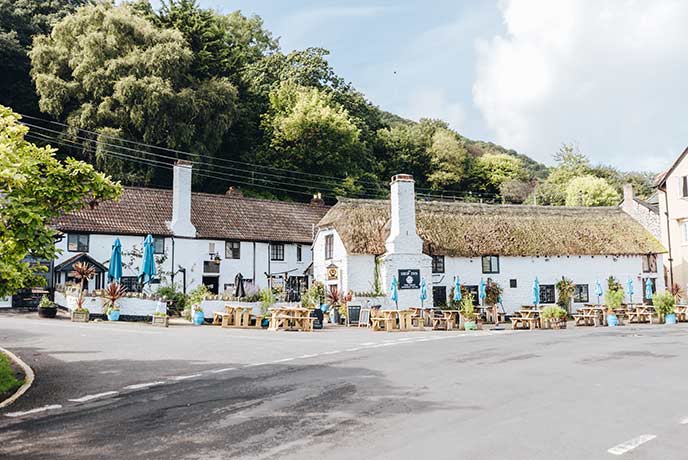
One of the oldest inns in Exmoor, The Ship Inn sits within the pretty portside town of Porlock. In the summer months, enjoy the scenic setting from the outdoor seating area, while in the winter, you can snuggle up next to a roaring fire. Serving up simple locally-sourced food, they’re also known for a great Sunday roast.
Woods Bar and Restaurant, Dulverton
Serving British food with a continental twist, Woods Bar and Restaurant is an award-winning pub nestled in the Exmoor countryside. While its food sings, so does the ambience: expect a rustic hand-built wooden interior and quirky decorations that combine to create the cosiest atmosphere.
The Luttrell Arms, Dunster
Just a few miles from Minehead, The Luttrell Arms sits within a storybook medieval village overlooked by Dunster Castle. With the elegance of a country house and award-winning food to boot, you can enjoy an AA-rosette meal in the Psalters restaurant or more casual bites in the bar and garden.
The Exmoor White Horse Inn, Exford
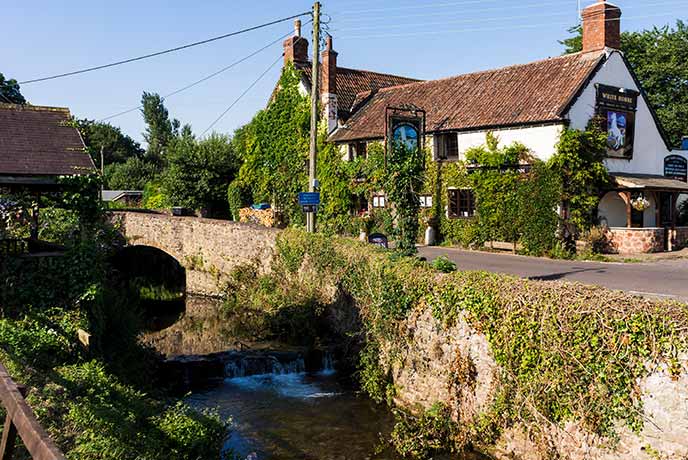
With a storybook setting by the winding River Exe, The Exmoor White Horse Inn is as quintessential as you can get. Ivy climbs up the walls of the historic 16th-century inn, while the pretty pub garden promises a lovely spot to sit back and relax with a drink in hand. The menu is simple, hearty, and ideal for all who seek a toothsome refuel after a walk across the moors.
The Ancient Mariner, Lynmouth
For a magnificently maritime-themed pub experience, head to The Ancient Mariner in Lynmouth. Its eccentric memorabilia includes an octopus sculpture and a full-sized torpedo, which has earned it the reputation as one of the quirkiest pubs in Devon. Food-wise, you can expect pub classics served with local beers, ciders, and ales – or, pop next door to the Bath Hotel if you fancy a more luxurious or romantic meal.
Ready to don your hiking boots and pack your swimmers for a weekend exploring Exmoor National Park's beautiful coastline and patchwork interior? Browse our luxurious holiday cottages in Exmoor National Park to discover your dream bolthole.


